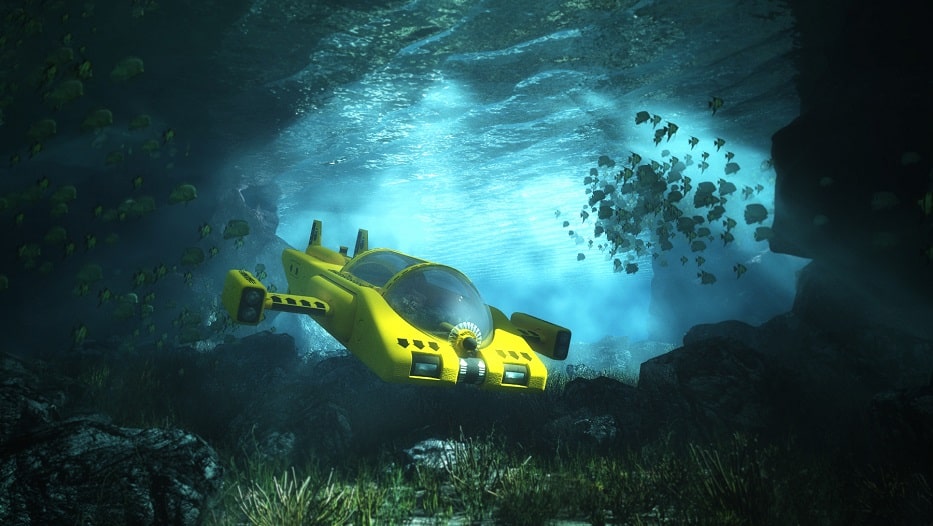The marine sector has added an innovative partner to its undertakings in environmental research, construction, or repairing of subsea infrastructures: remotely operated vehicles capable of reaching hard-to-reach locations quickly and safely.
The technological transition of the maritime sector is rapidly advancing, transforming ports and revolutionizing the operability of its fleets, as we have seen in a recent article in the Magazine. Among the technologies that are gradually conquering the seas, robotics stands out and, with it, one of its headline developments: the Remotely Operated [Underwater] Vehicles (ROV). There are many functions of these subsea vehicles nowadays: from the conservation of ports and dams to exploration or the maintenance of thermal power plants.
Unmanned vehicles have become an important partner in complex missions such as environmental research or building and repairing underwater infrastructures, but they have also had their own trajectory of innovation. Since the Frenchman, Dimitri Rebikoff, developed Poodle – considered to be the first remotely operated underwater robot – in the 1950s, the evolution has been relentless.
Raúl Marín Prades, professor at Jaume I University and researcher at the Center for Research in Robotics and Underwater Technologies (CIRTESU), explains how, since that first robot, their developments and applications have been many.
These vehicles are generally controlled by a human operator who is not physically inside the vehicle
“In Spain, as far as we currently know, the first time an ROV was used was in 1966, in the so-called CURV project, where US teams arrived at the village of Palomares, in Almería, where the collision of two US Air Force aircraft had caused four thermonuclear bombs to be dropped. In that operation, mini submarines were used precisely to recover the devices,” he explains.
Greater autonomy
Since that first push, we have been enhancing both the efficiency and abilities of these robots to, among other challenges, increase their independence. These vehicles are generally controlled by a human operator who is not physically inside the vehicle. This guidance work can be done via radio signals or through a cable connecting the vehicle to where the operator is located. This umbilical cable – commonly referred to as a tether cable – establishes the connection between the pilot and the ROV by managing both the vehicle’s power and the data transmission itself (video, telemetry, sensors, sonar, etc.).
“This is one of the points of improvement, without a doubt. On many occasions, it was not feasible to operate these devices by cable because underwater – at large depths and with significant sea currents – that cable can get hooked onto a rock or may simply become disconnected,” says Professor Marín Prades.
“The goal is to get these ROVs to the point where to send the information that they are collecting in real time.
But above all, that potential loss of connection has led to many advances in the communications technology that these vehicles incorporate. “The goal is to get these ROVs to the point where to send the information that they are collecting in real time. That’s why research is being conducted into new technologies such as Visible Light Communication (VLC), which offers a lower range than sonar (50 meters) and, above all, a higher and much-needed transmission speed, for example, for sending images.”
The autonomy of the ‘Remotely Operated Vehicle’ is another of the most important challenges in the industry and, again, research has managed to respond to said challenge with the creation of HROVs, a hybrid model that no longer needs to be electrically powered by any cable, since it is equipped with its own batteries, and thus being able to be used with or without umbilical cables. However, as the professor points out, it is necessary to continue innovating, since autonomy in this type of ROV generally “does not last longer than eight hours.”
Another recent innovation are the so-called Autonomous Underwater Vehicles (AUVs), which travel underwater without requiring ongoing intervention from a human operator.
“The main line of research today is, in addition to improving communications technology, the autonomy of these vehicles and the development of more advanced user interfaces, with Augmented Reality, to make it possible for us to teach these ROVs to perform specific tasks practically on their own,” the expert remarks.
The presence of ROVs is growing every day and their technological evolution will allow us to see them ‘working’ in more areas under our waters,” concludes Marín Prades
In the waters of CIRTESU
Many are the currents that are hidden under CIRTESU and all are related to innovation in robotics and underwater technology. Waters in which Raúl Marín Prades, to be precise, handles himself perfectly well and in which he leads the Improvement of submarine cooperative manipulation through learning, augmented reality and wireless communications project.
“The goal is to teach ROVs how to collaborate and work on underwater construction,” the researcher explains. An arduous task that currently involves three autonomous robots capable of manipulation and three universities: Jaume I University of Castellón, the University of Girona and the University of the Balearic Islands.
One more step, without a doubt, in a race for innovation in which the ‘Remotely Operated Vehicles’ are being called upon to act as great underwater partners for a multitude of sectors and activities. “From tasks where every minute counts, such as rescue operations, to the study and research of the seabed, wind energy or aquaculture, going on to activities of construction under the sea and the maintenance of dams and power plants. The presence of ROVs is growing every day and their technological evolution will allow us to see them ‘working’ in more areas under our waters,” concludes Marín Prades.
Contributor to this article:
 Raúl Marín Prades, professor at the Jaume I University and researcher at the Center for Research in Robotics and Underwater Technologies (CIRTESU).
Raúl Marín Prades, professor at the Jaume I University and researcher at the Center for Research in Robotics and Underwater Technologies (CIRTESU).
With a Bachelor of Science in Computer Engineering (1996) and a Doctorate in Engineering (2002) from the Jaume I University of Castellón, Marín Prades has participated in numerous research projects such as the EU FP6 GUARDIANS (a group of unmanned assistant robots deployed in aggregate navigation supported by odor sensors), the EU FP7 TRIDENT Project (marine robots skilled in manipulation abilities to enable autonomous missions of multi-purpose underwater intervention) and the EU H2020 El-Peacetolero (embedded electronic solutions for polymer innovative scanning tools using light emitting devices for diagnostic routines).
Keep reading… Submarine cables: more than just an essential ‘Telco’




